This was my 4th trip on the Suwannee River with Paddle Florida, my 5th trip overall. We were supposed to meet at Madison Blue Springs State Park, spend the night, then paddle the Withlacoochee River to the Suwannee and Suwannee River State Park the next day. Both extremely low water levels on the Withlacoochee and the arrival of Tropical Storm Nestor changed those plans and ushered in days of gray skies and rain.
Videos and Photos
Just as we prepared to launch our boats on the first day, another paddler carelessly lifted her boat over mine, hitting my deck camera and breaking off the deck mounted tripod. As a result, I was unable to make videos while moving on the water. The videos I did make have become more of a video diary. I just wonder what kind of video I might have gotten as I shot through the second rapid, glancing off the wall and capsizing. I bet it would have been great!
After two days in the rain at Suwannee River State Park, we were able to launch on Sunday morning. We were cautioned about shoals on the river because it, like the Withlacoochee, was also at record low levels, some three inches below the recommended minimum water level for paddle craft. We were told to be alert for exposed rock and fast moving water, especially on this first, fifteen mile leg of the trip. It wasn’t long before the roar of water pouring over exposed rock could be heard echoing between the high limestone walls of the river; shoal ahead, and a big one.
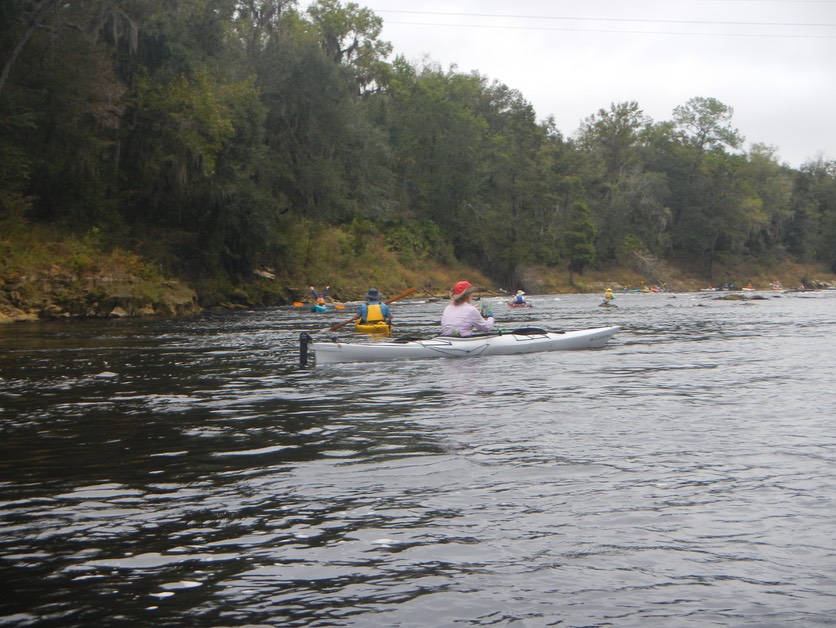
Several kayakers had gotten to the small, class two rapid, had scouted out the best path through, and were waiting below, calling out directions to those above. The best route was to the far right, which seemed counter intuitive because that’s where the river seemed most turbulent. The river was completely blocked by exposed rock except in this far corner where deep water rushed through an unobstructed opening. Waiting my turn, I hit the opening just right and blew through at 7.8 miles per hour as shown by my GPS. Finally in the calm water the bottom, I turned and took videos of the others coming through the slot.
After another mile or two of flat water, that familiar roar echoed up the river once more, producing a knot in my stomach. As I approached and watched the first kayakers navigate through a narrow slot filled with rushing water, I could see a sixty degree turn to the left as you exited the slot. When it was my turn, I chose the line I wanted to take through the passage and accelerated forward. I was immediately caught in the turbulent flow, too close to the vertical wall on my right. I pushed off with my paddle, but couldn’t quite make the turn, slamming into the obstruction as the water rushed through the shoal toward calmer water down stream. For an instant that seemed much longer, I held myself not quite upright while the boat careened through the turn. Another bump and I was upside down, looking at the rocky bottom of the river. It took a second to realize what had happened, but I quickly popped my spray deck and came up trying to hold on to the boat and my paddle as I rushed through what was left of the shoal. I was embarrassed but unhurt as the folks in the calm water below collected my errant gear and helped me get back into my boat.
The rest of that day’s fifteen mile paddle was comparatively uneventful. We arrived at Dowling Park River Camp in less than four hours.

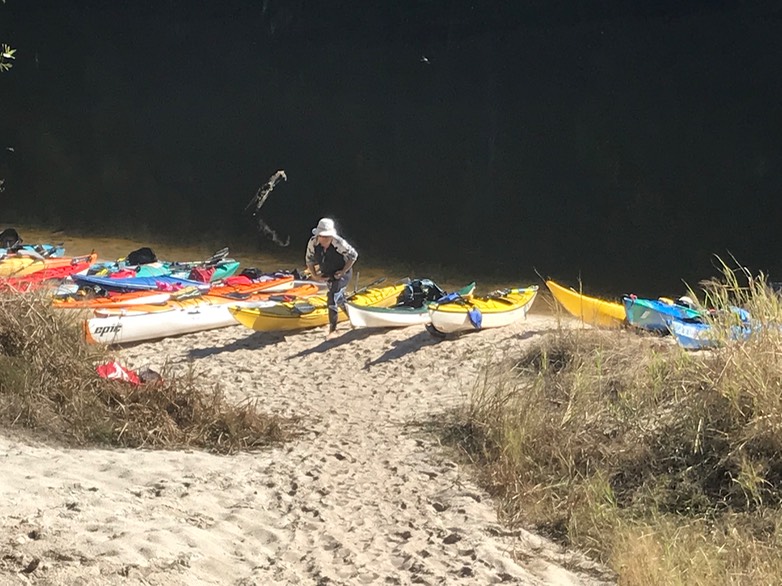
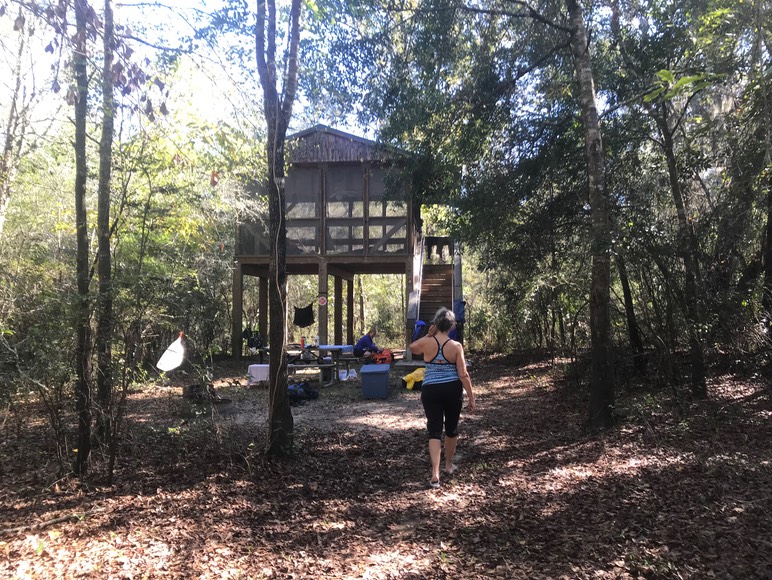
Dowling Park is one of the several river camps on the Suwannee River Wilderness Trail. Because the water was very low, there was easy access to areas where we could beach our boats and carry gear into camp. The river camps are unique in that they are designed for paddlers and fishermen with no public access from the land. All of the camps have flush toilets and hot showers. each one has five or six screened and roofed platforms with electricity, lights and fans. In some of the camps these platforms are raised twelve or more feet off the ground and the bathroom and showers are on wheels to be dragged out in the event of flooding, as the Suwannee, flowing out of the Okeefenokee Swamp in Georgia can rise as much as twenty feet in a very short time, depending on what’s happening upstream. Platforms can be reserved but are also available on a first come, first served basis. Unbelievably, there is no fee for using the camps.
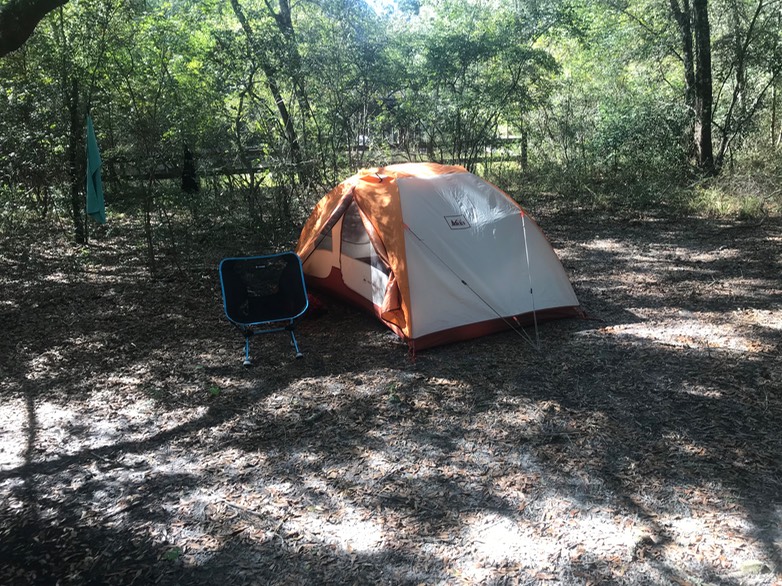
I have camped on these platforms with two other friends, without using tents. This works when people know each other and wind and rain are not expected. On this trip, people were setting up tents in the screened platforms for privacy and protection from the unpredictable weather. I decided to set up my tent in the camp's wilderness camping area.

Lafayette Blue Springs State Park
The late afternoon sunlight shining through the high late Fall trees in the Dowling Park River Camp wilderness tenting area felt wonderful after so much rain. Still, the humidity was smothering. I was constantly either wet from paddling or damp from the oppressive atmosphere. Even clothing stored in dry bags came out feeling damp and clammy. Nothing dried out.
After a warm night, I awoke to the whole inside of my rainfly soaked from my own respiration condensing on it, while the outside was relatively dry. I hate packing up wet, but nothing was drying, so I rolled the tent up and packed it into its storage bag, damp and dirty.
After breakfast, we headed out at our usual 8:30am launch time for our ten mile paddle to Adams Tract River Camp. The distance was short so lunch would be at the river camp. I was using the Greenland paddle for the second day and really struggling with it. It seemed to aggravate my arthritic right hand and didn’t have the push I was used to with my Euro blade. Still, the Greenland was supposed to be easier on your shoulders, allowing you to paddle for more miles than the Euro. The trade off, however, was needing to paddle many more strokes to go the same difference. We’d see what challenges and rewards this day’s paddle with the Greenland blade would bring.
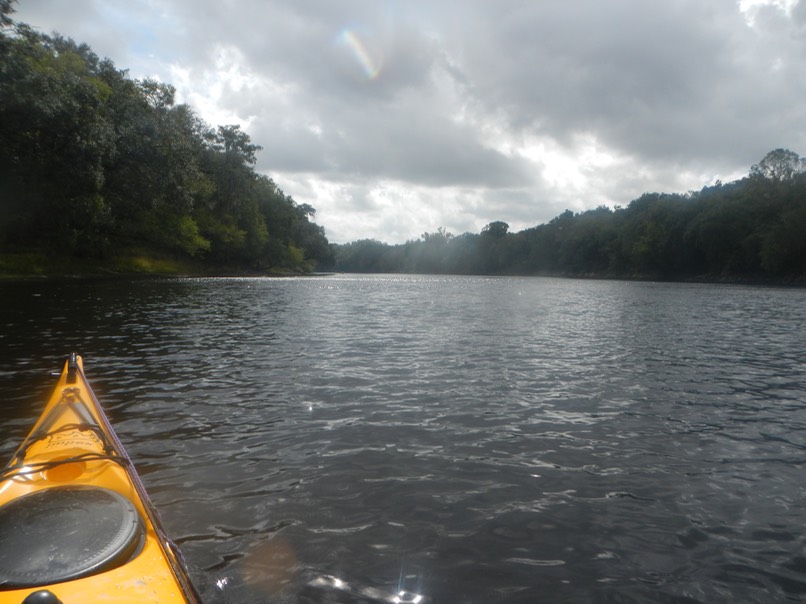
The day began as all the others had so far; gray and overcast, with a light breeze. The Greenland paddle drops a lot of water in your lap, or in my case, on the spray deck. That’s because there is nothing to stop water on the raised end from running down the the long, thin blade, to puddle up in your lap or on your deck. As my spray deck was old and worn, a veteran of many trips, it was prone to leaking, just adding to the feeling of never being dry.
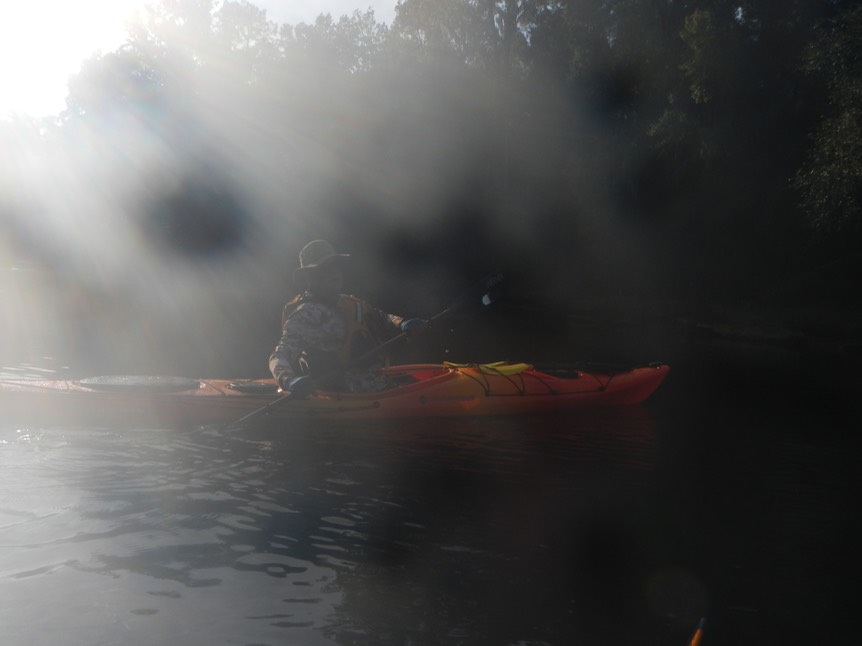
As you can see from this picture, even my camera lens was fogging up. Anyway, given all of my complaints, it was a nice paddle. The river from here to Manatee Springs, straightens out and widens, becoming easier to paddle, while at the same time, less interesting. The beach takeout at Lafayette Blue Springs State
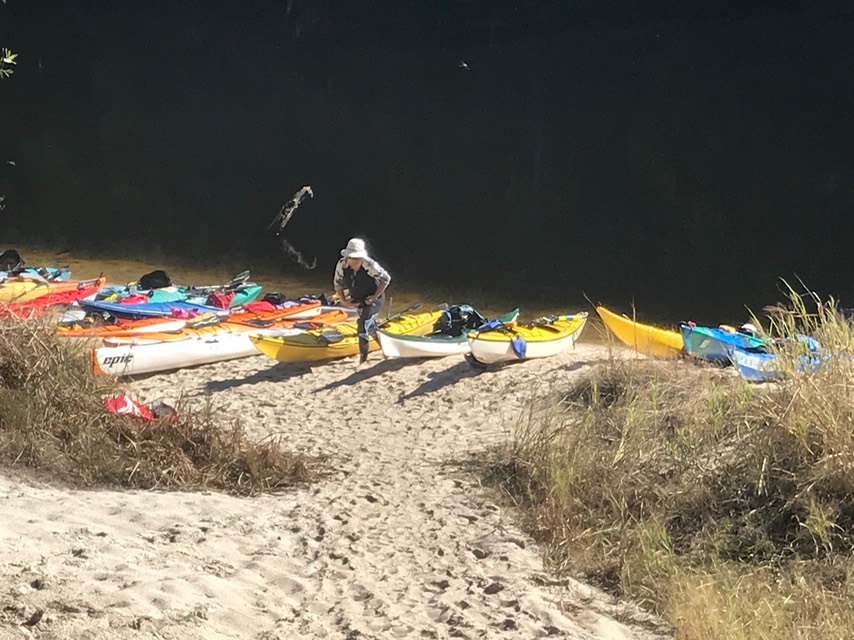
Park was one of the easiest we would see on this trip. However, given that the river was so low, this beach might be under water at other times. Instead of my usual arrival in the first group of paddlers, I was somewhere back in the pack, struggling with that paddle. On arrival, I was met my Joe, an early arrival at the park, who told me that he and Amy had rented one of the five park cabins, only available because other visitors had cancelled their reservations because of the weather. It had two bedrooms and, he insisted, one was reserved for me. The prospect of air conditioning and a warm shower overcame my “tough-it-out” attitude. I grabbed my gear and headed for cabin number 2.
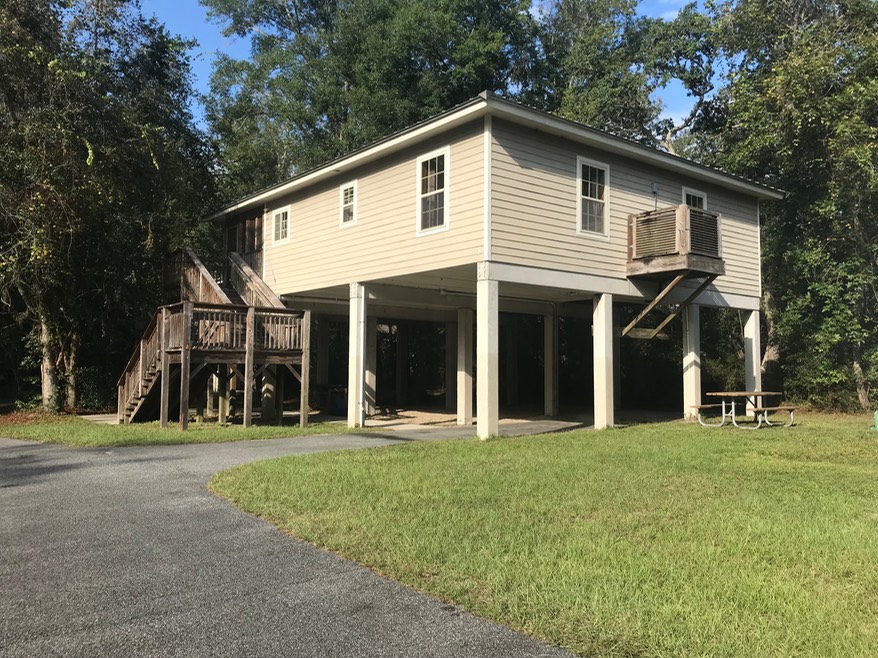
If you haven’t experienced any of these state park cabins, they are not the rustic, cobwebbed, makeshift arrangements your grand parents had. This one was raised about twelve feet off the deck to protect against flooding. It’s porch wrapped around two sides, with a picnic table on the short side and four rocking chairs on the long arm. Inside was a living room with a fireplace, a kitchen with all the appliances you’d expect, a full bath with hot shower, air conditioning, and two bedrooms. All for about $120.00 per night, including taxes.
After hauling my gear up the stairs and taking that hot shower, I laid some gear out on the porch to dry, then took my tent downstairs to set it up under the cabin, giving it a chance to dry out as much as it could in the humidity and intermittent rain. After a great southern fried fish dinner by our caterer Darrel Dooby and a short program, I turned in for a cool, dry and peaceful night’s sleep, feeling blessed by the generosity of my friends.
By the way, as is often the case, names in the South are pronounced differently than in the North. Where I come from Lafayette is pronounced “La fay ETTE”. Here in Florida, Lafayette is pronounce “La FAY ette". So use this pronunciation to sound like a local.

Rain, Rain, Go Away!
I paddled the first two days and twenty-five miles of this trip using a Greenland paddle. I had struggled with it, having trouble keeping up with the crowd, sure I couldn’t go fast when I wanted too. I found that the oval shaft, designed to give a tactile feel for the orientation of the blades, caused my arthritic hands to ache. So, for today’s eighteen mile jaunt to Adams Tract River Camp, I switched back to my Euro paddle, leaving the Greenland in the truck.
After eighteen miles with the Euro, I felt like I could have done five more! After another dry night’s sleep on a river camp platform with Amy and Joe, I was ready to go home.

To Branford, Ivy Memorial Park, and Home
After a cold morning start from Adam’s Tract River Camp, we enjoyed perhaps the best paddling of the trip. Skies were sunny and blue with a slight breeze. The ten mile paddle on the now broad river was pleasant and uneventful. We quickly arrived at Ivy Memorial Park in Branford, landing on the large concrete ramp designed for powerboats, another sign we were moving closer to the Gulf and powerboat traffic.
The paddlers were in an upbeat mood as they helped each other carry boats up the ramp to waiting cars. Doobie was there and soon had a hot lunch for us as gear was being packed and people said their goodbyes before heading home. I delayed joining the exodus, not wanting to get home until after Lisa’s Bridge club had ended at five O’clock.